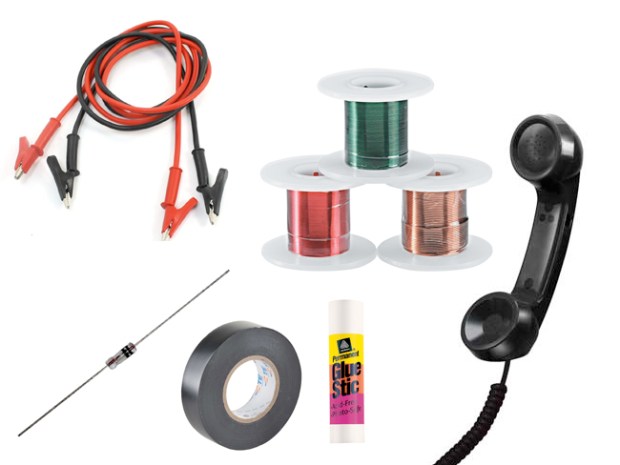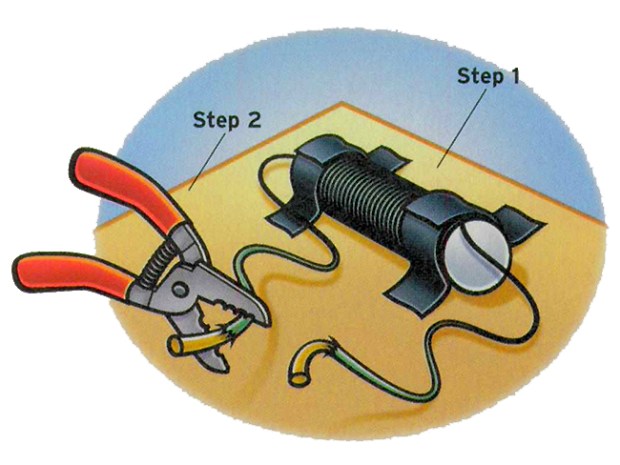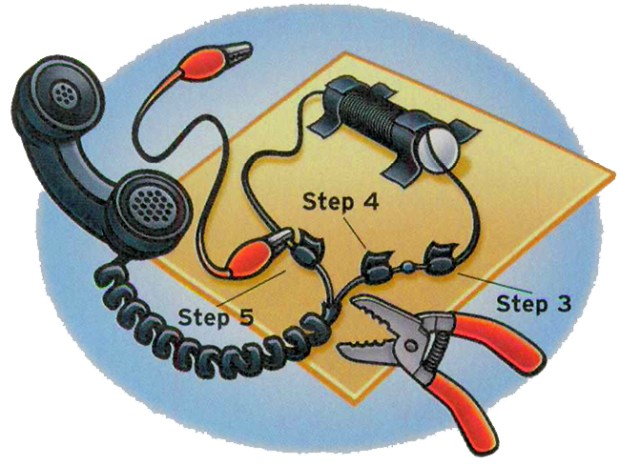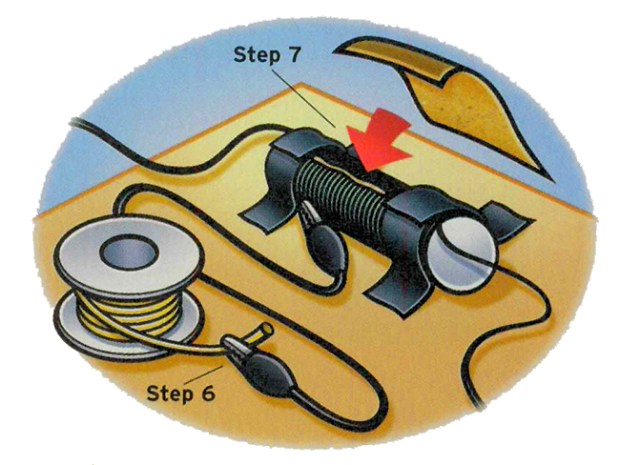How to Build a Homemade Radio That Really Works
Radios might seem super high-tech. But with about $15 and one afternoon, you can make one at home.

Click here for a PDF version of these instructions.
WHAT YOU’LL NEED
- Magnet wire: Electronics supply stores often sell a set, for about $10, that comes with 40 feet of 22-gauge, 75 feet of 26-gauge and 200 feet of 30-gauge magnet wire. You can also find it at Amazon.com or Radioshack.com.
- 1 set of alligator leads with clips at each end.
- 1 diode: Look for IN34A diodes, also called “germanium diodes,” at an electronics supply store or online.
- 1 glue stick or anything similar in size — about 1 inch by 1 inch by 6 inches. It can be a piece of wood. It doesn’t have to be perfectly round, but using something round is easier for winding.
- Electrical tape
- Wire stripping pliers
- Telephone handset with cord. If you don’t have an old phone that you don’t use anymore, you might be able to find one at thrift stores or garage sales.
- One board for mounting your radio — 2 feet by 2 feet will work. You can make the radio without this, but having a workspace and a place to mount the radio makes it easier to carry around while you’re looking for a place to hook the ground wire.
WHAT YOU’LL DO

Step 1: Wind 26-gauge wire (the green magnet wire) around the glue stick until it covers nearly the entire cylinder. Keep the wire tight. Leave about six inches of wire on each end. Once you’re finished winding it, tape around both ends of the cylinder to make sure the wire holds. Then, mount the coil to the board with electrical tape.
Step 2: Strip the ends of the wire you’ve left from each end of the coil. Use wire stripping pliers or sandpaper. The wire is very thin. Removing the enamel and exposing about one inch of the wire should be easy.

Step 3: Attach the wire from the right side of the coil to one end of your diode. Tape the connection.
Step 4: Cut the end of the phone cord and strip about two inches of it. It should expose two wires. Strip those wires. Take your time; this wire is thin. (Try this tip: Before hooking up the tiny telephone cord wires, get some thicker insulated magnet wire and tape about two inches to each wire. This will make the rest of the job easier.) Attach one end of the wire to the exposed end of the diode. Tape that connection.
If your phone cord has four wires instead of two, you have to figure out which two will work. Take a 9-volt battery and place one cord against the positive (+) pole of the battery and another cord on the negative (-). When you find a combination that makes a clicking sound in the headset, you have found the two wires to use.
Step 5: Connect the second telephone wire to the green wire coming from the left side of the coil. Before taping this connection, clip one of the alligator leads to it. Tape those three wires together — the alligator lead (that’s your ground wire), the telephone wire and the wire coming from the left side of the coil.

Step 6: Make your antenna by clipping one of the remaining alligator lead wires to one end of the 22-gauge magnet wire. Leave this wire on its roll.
Step 7: Scrape a thin strip of enamel from the wire wrapped around the glue stick. You can do this with any sharp object or a piece of sandpaper.
SEE IF IT WORKS
Attach your telephone cord to its handset.
Find a good ground for the alligator wire that’s connected to the left side of your coil. A pipe going into the ground is perfect.
Unroll the antenna wire and hang it over a tree branch with help from an adult.
Touch the alligator clip that leads to your antenna wire to the top of the coil. You should be able to hear an AM radio signal.
TROUBLESHOOTING
If you can’t get any signal, it’s probably your ground wire. With permission from an adult, unscrew one bolt that holds the faceplate to a light switch or outlet. Unscrew it just enough to hook your alligator clip. Don’t remove the plate.
If you get a weak signal, it’s your antenna. If your parents have an old television antenna, hook your radio antenna wire to one of the connections on the TV antenna wire instead of running wire up a tree.
PHOTOS OF COMPLETED PROJECT
Check out these photos of the completed project sent to us by Scout Life readers. If you have a photos of a SL Workshop project, please use the form below to send them to us.


Does it need a battries
Thanks!
VERY NICE 1
i’m about to make it as a science project in school
do yourself a favour and do not waste time on this
is there any youtube video of yours
How do you tune the radio?
Try using an old amplified computer speaker instead of the phone receiver
why do we need 75 feet of wire?
Does the telephone handset have to be a newer variant or can any sort of operable telephone handset work, including old Western Electric models?
Can you use a cell phone for this?
no, but instead of an old handset, you could also use a cheap pair of headphones.
super helpful!!!!!!!!!!!!!!!!!!!!!!!!!!!
does it need a battery
Hi boyslife, thank you so much for this Homemade Radio. Can I use a small speaker or headset right? Instead of a Telephone handset.
If you don’t mind, the diode polarity not mention and 30-gauge magnet wire.
no
now i can make a radio
okay you need a toolbox then straps to hold battery drill hole for the n feamale chassie panel mount connector then you need a coaxial cable with a pl259 connector, then make sure all the wholes are drilledeven for your power cord and connectors then tconnect your antenna then try it.
Can we scale it down to fit in Altoids Tin
Do you happen to have a schematic of this radio that I can see?
probably
amazing!!!! question though instead of telephone wire could you you earbud wire?
How to make radios?
Thank you Boys Life for this wonderful DIY article. Simple, elegant and instructive.
necessity is the mother of invention
will people hear you over their radio when you speak ?
what can we hear in it?
how long does it take
how much more complicated can these things get???
MUCH more complicated
I too built one in 1950. I lived in Mass. and was able to pick up WWVA Wheeling
West Virginia. Now I am considering helping my grandchildren build one also.
are u dead
Is this different from a crystal radio? How
It is a crystal radio. A crystal radio does not have a crystal.
Where do you get a IN34A diodes? Radio Shack doesn’t have them and the ones we find online are $0.30, but the shipping is ~$5. Being thrifty Scouts we are wondering where to obtain this diode or if the diode can be substituted with some other diode.
try wal-mart
i saw that to
Apparently, at an electric supply store, i.e. radioshack®, etc.
have you tried ebay ?
epIc LoL XD
I think it would work better if you used an old metal shirt hanger for a antenna
The antenna has to be long for these frequencies or it will not receive any signals because most of the time if the receiving antenna is shorter than 1/4 wavelength on that frequency it will receive poor reception or no reception at all.
With AM broadcast that’s not really the case. A long antenna will improve range, but most stations broadcast at a high enough power that even short antennas work well for receiving. This is why consumer AM radios have internal antennas.
it would work better if you had the
k3797 diodes.if you angle the batter 70 it will get better receptions. thats my way
i’m about to make one
WOW that was a mouth full radio receiver 332 lol 😛
Great project im going to make one
Same here!!
THis is an awesome project for a rainy day.
If you get noise on your radio headset, but no radio stations, use a metal paper clip to try to tune your hand built radio. Sometimes it helps to run a number 26 guage wire and connect it with a metal screen of a no longer used storm window (to enlarge the radio antenna receiving area). If you live on a farm and can receive AM Radio Stations on a battery operated portable radio, see how strongly the station broadcasts to the radio. Sometimes, radios in cars and table radios have stronger antenna receptions due to the design of the radio. If the storm window screen that is connected to your hand built radio is located off of the ground, the reception might be a little bit better. Some farms who receive AM Radio station programs have their table radios connected to antennas which are connected to Farm Towers that are taller in height than the chimney of the farm house or slightly taller than the grain storage containers.
what is it like to live on a farm?Im alraedy working on the raidio.
It is pretty cool. You have to take care of animals and cut alfalfa to make hay to feed horses and to use as bedding for dogs.
what do you do with the paper clip!?